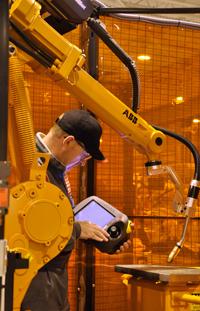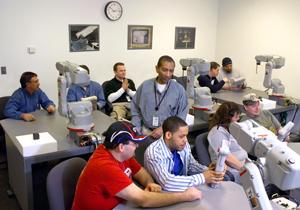Editor-in-Chief
- FMA
- The Fabricator
- FABTECH
- Canadian Metalworking
Categories
- Additive Manufacturing
- Aluminum Welding
- Arc Welding
- Assembly and Joining
- Automation and Robotics
- Bending and Forming
- Consumables
- Cutting and Weld Prep
- Electric Vehicles
- En Español
- Finishing
- Hydroforming
- Laser Cutting
- Laser Welding
- Machining
- Manufacturing Software
- Materials Handling
- Metals/Materials
- Oxyfuel Cutting
- Plasma Cutting
- Power Tools
- Punching and Other Holemaking
- Roll Forming
- Safety
- Sawing
- Shearing
- Shop Management
- Testing and Measuring
- Tube and Pipe Fabrication
- Tube and Pipe Production
- Waterjet Cutting
Industry Directory
Webcasts
Podcasts
FAB 40
Advertise
Subscribe
Account Login
Search
Five traits to look for in a robotic weld cell operator
The right person can make the most of robotic welding
- By Dan Davis
- Updated May 9, 2023
- January 14, 2010
- Article
- Automation and Robotics

Figure 1: Robotic cell operators who can visualize how the robotic welding arm moves around a part can become very successful programmers. Photo courtesy of ABB Robotics.
The ugly truth in metal fabricating is that an automated welding cell is just as capable of turning out bad parts as an inexperienced welder. In both instances, it goes back to human error.
Only in the most advanced automated setups do humans have no interaction with automated welding technology. Even in the world of high-volume, low-mix manufacturing, where an engineer has set up the amps and volts in the welding equipment and locked out the operator to prevent tampering with the equipment, the operator hits a cycle button. Most metal fabricators, however, live in the world of low-volume, high-mix manufacturing, where the jobs can range from simple to complicated within the same hour. Operators not engaged in their job of overseeing an automated welding operation can create new headaches for a management team that thought its production headaches would disappear with the investment in robotics.
The best way to prevent the headaches and protect the investment is to find the right person for the role of robotic welding cell operator. Here are five traits to look for.
No. 1: Experience Counts
Many vendors position their robotic welding equipment as the perfect answer for shops that can't find enough welding talent. The thinking is that you can take an inexperienced welder who is comfortable with new technology and have that person operate the welding cell with little trouble. That may be the case, but that shop is making a sacrifice. Experienced personnel are the best insurance against quality problems and resulting costly downtime.
"A skilled eye will spot either an obvious surface defect, which can be a symptom of something more sinister underlying, or it can be a previous process not performing," said Mark Oxlade, arc welding specialist, ABB Robotics North America.
The American Welding Society (AWS) stresses experience with its certifications related to robotic arc welding. For a welder interested in becoming a certified robotic arc welder operator, the AWS requires the person have a minimum of two years of welding experience and a one-year diploma in welding or robotic instruction before a test can be taken. If that same welder is interested in becoming a certified robotic arc welder technician, that person has to have been welding for at least five years, have a two-year associate's degree in welding/robotics/electrical or an equivalent degree, and be a certified welding inspector.
Of course, advanced control software makes it possible to control the many variables of the welding process, but hundreds of earlier-generation welding cells without the advanced capabilities still exist in the metal fabricating world. Oxlade said that's where a welder's experience really shines. The experienced welder knows that the right welding sequence ensures material integrity, realizes upstream processes may have the potential to affect the weld, and quickly identifies out-of-spec welds with a quick glance at the final joint.
In some instances, however, quality is in the eye of the beholder.
"I've seen operators have a different interpretation of what good and bad is, and that even happens with welders," said Buddy Smith, assistant manager of technical training, Motoman. "We've been in plants where the first shift likes welds to look like this, and the second shift likes it like this. It has gone so far where they have a different set of programs that they dump into the controller whenever they walk into the door, and they run their set of programs and take the other shift's out."
Documented welding procedures help to standardize processes. Experienced welding cell operators can help to ensure jobs are held to the documented specs.

Figure 2: Training operators for robotic weld cells works best when small groups have easy access to a robot to try out what they have learned. Photo courtesy of Motoman.
No. 2: Ownership Matters
Shop managers know the worst employees are the ones that show up physically, but not mentally. They fail to notice or ignore wire twist, gas, or fit-up problems and continue to push product through. They simply don't care.
On the other hand, those employees that are totally invested in the performance of the automated cell—keeping up the cell and moving parts in and out—stand out. They may not have the most welding wisdom, but they may be just as valuable to keeping up productivity.
"Shops that I like and that I visit have guys operating the machines who are also responsible for setup and often responsible for the maintenance. The load and unload process is just one part of the true charter, which is to produce good parts," said Joe Campbell, vice president, sales and marketing, ABB Robotics North America.
Think about the large benefits that result from the small improvements the "owner" of an automated welding cell makes. The operator moves consumables closer to the welding cell for convenience; in reality, the move has a positive effect on uptime. In another instance, the operator maintains a clean work environment around the cell; such a move can make a positive impact on a customer who may be touring the shop floor.
No. 3: Initiative Stands Out
It's one thing for an employee to maintain an organized work environment and keep parts moving through the cell. It's another thing to have an employee step forward, stop production flow, and raise an issue about quality. Hopefully, companies have created a culture where such concerns can be addressed if the employee has the initiative to step forward.
An employee's willingness to step forward in the name of quality is even more important with complex welding jobs. A welder working in a GTAW cell is a good example.
"TIG welding cells can be very difficult because the success of the application really does depend on the operator," said Chris Anderson, technology leader for welding at Motoman. "Whereas in a MIG welding cell, there is enough process tolerance. In TIG welding, the process window is narrowed, and so you really do need an operator that is conscientious."
The operator has to maintain the tungsten electrode, ensure proper wire guide positioning, and verify that parts sit in their fixtures as designed. The operator also has to step forward if production needs to halt. The resulting downtime represents a much better scenario than reworking parts because the quality issue wasn't addressed in time.
No. 4: A 3-D Mindset Helps
The ability to visualize in 3-D can help a welding operator. A welder can see how a robotic arm can move around a workpiece and figure out the best way to attack a difficult-to-reach area. (See Figure 1.)
ABB's Campbell described a display his company had at the recent FABTECH® International & AWS Welding Show in Chicago. The company's new IRB 4600 robot sat atop a 6-foot pedestal so it could reach over a complex part and weld the back side. The robot never would have been able to reach under or over the workpiece if it simply were placed on the side.
A work envelope might look good on paper, but it's no guarantee that the welding torch won't crash into something. The ability to see the whole process can help to prevent the risk of collisions.
Unfortunately, seeing this skill in others is not the easiest thing in the world. Campbell said he has not found a particular trait to look for as it relates to thinking in 3-D, but has had success finding developers who once were car mechanics.
"A good car mechanic has a 3-D visualization of how the engine works," he added.
No. 5: Familiarity With Computers Makes Life Easier
Experience and familiarity with a PC help a welder make the transition to a robotic welding cell operator. Those skills enable an operator to jump right into all the benefits that modern control software has to offer.
For example, some software packages run simulation routines that tell an operator what will and won't work. The operator can foul up a welding routine, and the only thing lost is a couple of minutes in front of the computer.
And don't assume that just because young people are used to working with PCs and video games that they are the best candidates to operate a robotic welding cell.
"A younger person may be more comfortable pushing a button that they may not be able to troubleshoot a problem if something doesn't work," said Motoman's Greg Suiter, supervisor of application technicians.
Training takes place with pendants and close proximity to robots (see Figure 2), so the interaction between operator and robot is not truly connected to a PC, unless offline programming is taking place. This scenario might prove useful for those who are uncomfortable sitting in front of a computer.
ABB's Oxlade added that virtual pendants also can be brought up on a computer screen to help the operator become more comfortable sitting in front of a glowing screen.
Proper Training for Robotic Weld Cell Operators
Once potential robotic welding cell operators have been identified, selecting the right training is imperative. Smith said shop managers have to find a training approach that engages the would-be operators.
"In other words, it's not just a lecture where you say how it works and send you out to the floor," he said. "They need to have some hands-on. They need to be engaged, tested, and evaluated on their skills."
If those being trained have some of the aforementioned traits, they should produce some pretty good evaluations.
About the Author

Dan Davis
2135 Point Blvd.
Elgin, IL 60123
815-227-8281
Dan Davis is editor-in-chief of The Fabricator, the industry's most widely circulated metal fabricating magazine, and its sister publications, The Tube & Pipe Journal and The Welder. He has been with the publications since April 2002.
Related Companies
subscribe now

The Fabricator is North America's leading magazine for the metal forming and fabricating industry. The magazine delivers the news, technical articles, and case histories that enable fabricators to do their jobs more efficiently. The Fabricator has served the industry since 1970.
start your free subscription- Stay connected from anywhere

Easily access valuable industry resources now with full access to the digital edition of The Fabricator.

Easily access valuable industry resources now with full access to the digital edition of The Welder.

Easily access valuable industry resources now with full access to the digital edition of The Tube and Pipe Journal.
- Podcasting
- Podcast:
- The Fabricator Podcast
- Published:
- 04/16/2024
- Running Time:
- 63:29
In this episode of The Fabricator Podcast, Caleb Chamberlain, co-founder and CEO of OSH Cut, discusses his company’s...
- Industry Events
16th Annual Safety Conference
- April 30 - May 1, 2024
- Elgin,
Pipe and Tube Conference
- May 21 - 22, 2024
- Omaha, NE
World-Class Roll Forming Workshop
- June 5 - 6, 2024
- Louisville, KY
Advanced Laser Application Workshop
- June 25 - 27, 2024
- Novi, MI































